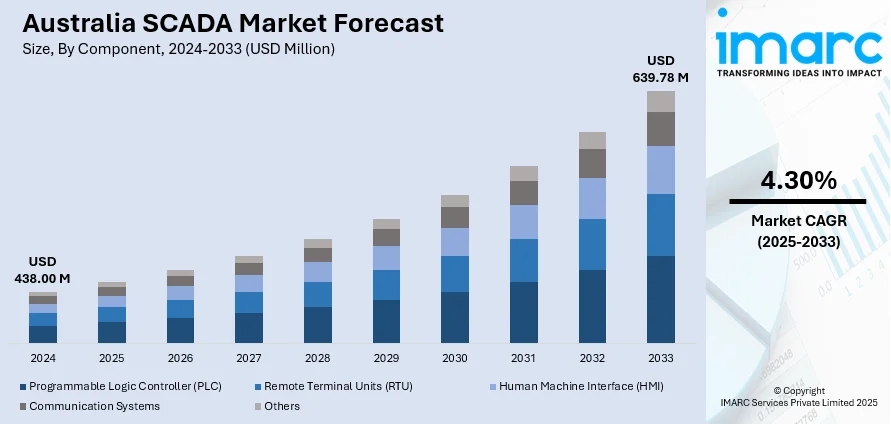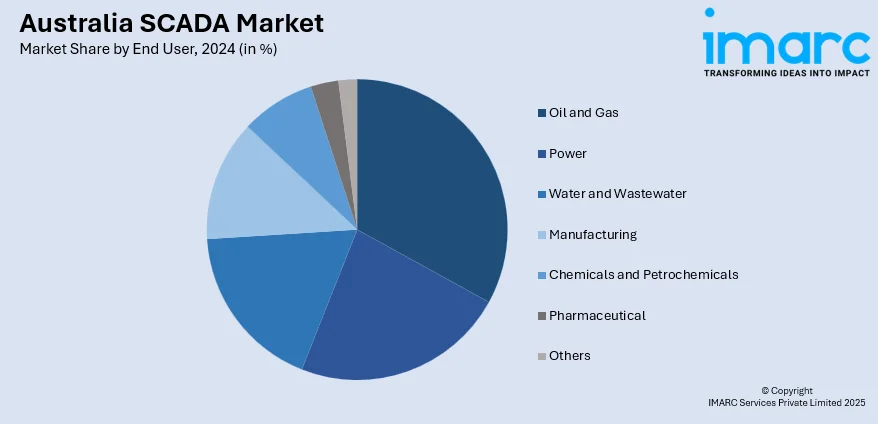
Australia SCADA Market Size, Share, Trends and Forecast by Component, Architecture, End User, and Region, 2025-2033
Australia SCADA Market Overview:
The Australia SCADA market size reached USD 438.00 Million in 2024. Looking forward, IMARC Group expects the market to reach USD 639.78 Million by 2033, exhibiting a growth rate (CAGR) of 4.30% during 2025-2033. The market is growing due to rising demand for real-time monitoring and automated control across sectors such as energy, water treatment, and manufacturing. The Australia SCADA market share is expanding steadily, supported by ongoing infrastructure upgrades and the increasing integration of renewable energy systems into core industrial operations.
|
Report Attribute
|
Key Statistics
|
|---|---|
|
Base Year
|
2024 |
|
Forecast Years
|
2025-2033
|
|
Historical Years
|
2019-2024
|
| Market Size in 2024 | USD 438.00 Million |
| Market Forecast in 2033 | USD 639.78 Million |
| Market Growth Rate 2025-2033 | 4.30% |
Australia SCADA Market Trends:
Growing Use in Green Energy Projects
SCADA systems are increasingly used to manage renewable energy infrastructure across Australia. As the country focuses more on low-emission energy, the need for better control systems has risen. SCADA supports the integration of energy from sources like solar and wind by helping operators oversee performance, detect faults, and adjust system settings in real-time. This capability is vital in managing the irregular supply patterns of renewable power. SCADA platforms can track energy generation, battery storage status, and load distribution, enabling better resource planning. Australia SCADA market growth is closely linked to the expanding role of automation in supporting these energy transitions. The shift towards large-scale renewable projects is pushing firms to install SCADA systems at various touchpoints. In late 2023, several solar farms in Queensland and New South Wales began using updated SCADA platforms for improved energy yield reporting and system health tracking. These systems help reduce downtime and improve grid balance. As the national energy mix continues to evolve, power companies are adding SCADA layers to connect renewable units with legacy grids. This helps stabilize fluctuations and manage distributed energy sources more effectively. The use of SCADA is expected to grow steadily in this segment, especially as Australia sets firm targets for clean energy adoption.

To get more information on this market, Request Sample
Demand from Industrial Process Upgrades
Australia’s industries are increasingly relying on SCADA systems as they modernize operations. Many sectors, including water utilities, oil and gas, and manufacturing, are turning to automation to improve accuracy, reduce human errors, and manage complex workflows. SCADA tools allow plant operators to control multiple machines and systems remotely while receiving real-time feedback and alerts. This not only speeds up production cycles but also lowers maintenance costs. One of the main drivers is the rise in aging infrastructure, which requires updated monitoring systems to maintain performance levels. SCADA platforms are being introduced as part of asset renewal programs in urban water and sewage networks. For instance, major water treatment upgrades in Victoria and Western Australia recently adopted SCADA to monitor water flow, pump performance, and chemical dosing. Additionally, oil refineries are updating legacy control rooms with new SCADA modules to detect system leaks and prevent equipment failure. These upgrades are often linked with cloud-based dashboards, offering operators remote access from control centers or mobile devices. The need to handle data-rich environments in real-time is encouraging companies to expand SCADA use beyond basic monitoring, turning it into a critical part of operational strategy. This trend is expected to continue as automation becomes standard.
Australia SCADA Market Segmentation:
IMARC Group provides an analysis of the key trends in each segment of the market, along with forecasts at the country and regional level for 2025-2033. Our report has categorized the market based on component, architecture, and end user.
Component Insights:
- Programmable Logic Controller (PLC)
- Remote Terminal Units (RTU)
- Human Machine Interface (HMI)
- Communication Systems
- Others
The report has provided a detailed breakup and analysis of the market based on the component. This includes programmable logic controller (PLC), remote terminal units (RTU), human machine interface (HMI), communication systems, and others.
Architecture Insights:
- Hardware
- Software
- Services
A detailed breakup and analysis of the market based on the architecture have also been provided in the report. This includes hardware, software, and services.
End User Insights:

- Oil and Gas
- Power
- Water and Wastewater
- Manufacturing
- Chemicals and Petrochemicals
- Pharmaceutical
- Others
As per Australia SCAD market outlook, a detailed breakup and analysis of the market based on the end user have also been provided in the report. This includes oil and gas, power, water and wastewater, manufacturing, chemicals and petrochemicals, pharmaceutical, and others.
Regional Insights:
- Australia Capital Territory & New South Wales
- Victoria & Tasmania
- Queensland
- Northern Territory & Southern Australia
- Western Australia
The report has also provided a comprehensive analysis of all the major regional markets, which include Australia Capital Territory & New South Wales, Victoria & Tasmania, Queensland, Northern Territory & Southern Australia, and Western Australia.
Competitive Landscape:
The market research report has also provided a comprehensive analysis of the competitive landscape. Competitive analysis such as market structure, key player positioning, top winning strategies, competitive dashboard, and company evaluation quadrant has been covered in the report. Also, detailed profiles of all major companies have been provided.
Australia SCADA Market News:
- March 2025: Yokogawa Australia secured an order from Melbourne Water to implement its OpreX Collaborative Information Server SCADA system, enhancing water supply operations. This development marked a significant step in modernizing infrastructure, improving efficiency, and supporting the growing demand for scalable, resilient SCADA solutions in Australia.
- October 2024: Modo Energy launched the ME BESS AUS NEM Index, providing a standardized benchmark for grid-scale battery storage across Australia’s national electricity market. This index, based on SCADA data, tracks real-time revenue and performance, enhancing market transparency and supporting operational optimization for battery systems.
Australia SCADA Market Report Coverage:
| Report Features | Details |
|---|---|
| Base Year of the Analysis | 2024 |
| Historical Period | 2019-2024 |
| Forecast Period | 2025-2033 |
| Units | Million USD |
| Scope of the Report |
Exploration of Historical Trends and Market Outlook, Industry Catalysts and Challenges, Segment-Wise Historical and Future Market Assessment:
|
| Components Covered | Programmable Logic Controller (PLC), Remote Terminal Units (RTU), Human Machine Interface (HMI), Communication Systems, Others |
| Architectures Covered | Hardware, Software, Services |
| End Users Covered | Oil and Gas, Power, Water and Wastewater, Manufacturing, Chemicals and Petrochemicals, Pharmaceutical, Others |
| Regions Covered | Australia Capital Territory & New South Wales, Victoria & Tasmania, Queensland, Northern Territory & Southern Australia, Western Australia |
| Customization Scope | 10% Free Customization |
| Post-Sale Analyst Support | 10-12 Weeks |
| Delivery Format | PDF and Excel through Email (We can also provide the editable version of the report in PPT/Word format on special request) |
Key Questions Answered in This Report:
- How has the Australia SCADA market performed so far and how will it perform in the coming years?
- What is the breakup of the Australia SCADA market on the basis of component?
- What is the breakup of the Australia SCADA market on the basis of architecture?
- What is the breakup of the Australia SCADA market on the basis of end user?
- What is the breakup of the Australia SCADA market on the basis of region?
- What are the various stages in the value chain of the Australia SCADA market?
- What are the key driving factors and challenges in the Australia SCADA market?
- What is the structure of the Australia SCADA market and who are the key players?
- What is the degree of competition in the Australia SCADA market?
Key Benefits for Stakeholders:
- IMARC’s industry report offers a comprehensive quantitative analysis of various market segments, historical and current market trends, market forecasts, and dynamics of the Australia SCADA market from 2019-2033.
- The research report provides the latest information on the market drivers, challenges, and opportunities in the Australia SCADA market.
- Porter's five forces analysis assist stakeholders in assessing the impact of new entrants, competitive rivalry, supplier power, buyer power, and the threat of substitution. It helps stakeholders to analyze the level of competition within the Australia SCADA industry and its attractiveness.
- Competitive landscape allows stakeholders to understand their competitive environment and provides an insight into the current positions of key players in the market.
Need more help?
- Speak to our experienced analysts for insights on the current market scenarios.
- Include additional segments and countries to customize the report as per your requirement.
- Gain an unparalleled competitive advantage in your domain by understanding how to utilize the report and positively impacting your operations and revenue.
- For further assistance, please connect with our analysts.
 Request Customization
Request Customization
 Speak to an Analyst
Speak to an Analyst
 Request Brochure
Request Brochure
 Inquire Before Buying
Inquire Before Buying




.webp)




.webp)












